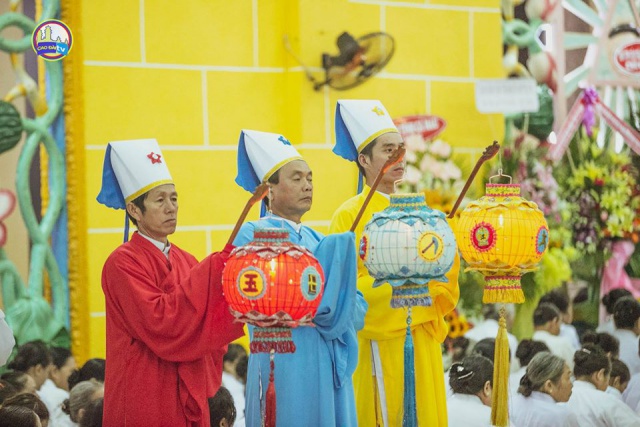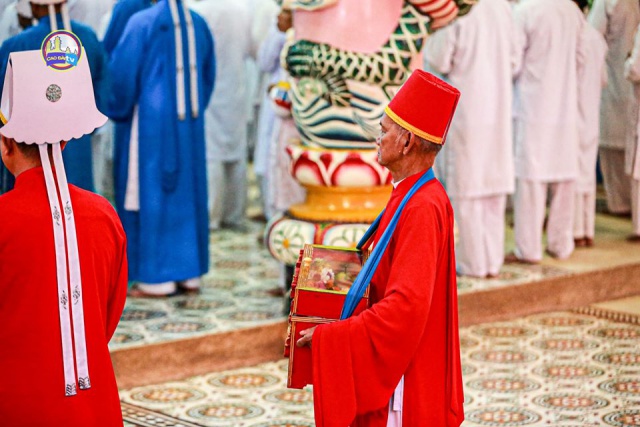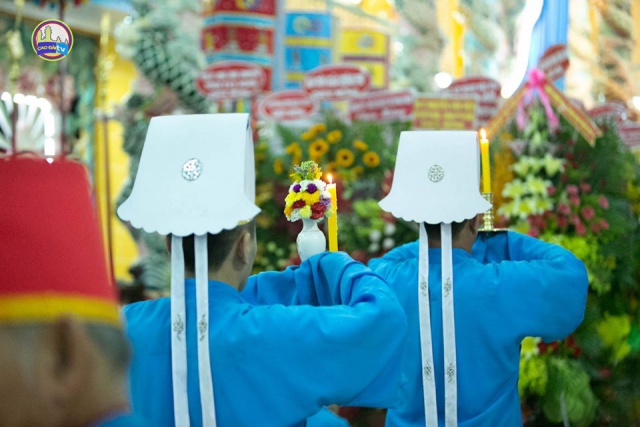CAODAI FAQ (Frequently Asked Questions) - Part III
Updated 2020-05-10 00:04:43
Compiled by Thanh Thuy and the Cao Dai Interpreter Youth Group
Corrected by Rev. Canh Tran and Chancellor’s Professor Joe Hobbs
Question 1: I see that all members join their hands, bow and prostrate. This must be the Caodai Mudra. Can you explain the meaning of this gesture?
Answer: The Vietnamese term of Caodai Mudra is called “Ấn Tý” (in Vietnamese, Ấn: mudra, Tý: year of Rat/first year of the Chinese lunar calendar) . This particular gesture of the hands underscores underlying esoteric meanings in Caodai teachings.
God’s message: “Left [hand] is the Sun, Right [hand] is the Moon, the two of them represent Yin and Yang. The unity of Yin and Yang created the Cosmos-genesis and from that all things have been given rise to and transformed, that is the way of Tao to be expressed”[1].
Accordingly, the left hand is an image of the Sun (belonging to Yang – masculine force), and the right hand is an image of the Moon (belonging to Yin – feminine force).
It is said that “Thiên Khai ư Tý” (Heaven was created in the period of year of the Rat) and“Nhơn sanh ư Dần” (Humanity was created in the period of year of the Tiger). That is why we put the tip of left thumb at the place of Rat (the root of left ring-finger, at the palm side) [see Image 1] and to put the tip of right thumb at the place of Tiger (the root of left index-finger, at the palm side) [See Image 2].
At the time we hold the clasped hands to form “Ấn Tý”. Ấn Tý is now a symbol of Supreme Monad, which embraces the interaction of Yang - Yin (Two constitutive forces) and the unity of Heaven – Humanity. This gesture indicates to“Vạn thù quy nhứt bốn” (All manifestations are reunited as Oneness).
When prostrating ourselves, “Ấn Tý“ will gradually lower to the floor and we also gradually open our hands to make a gesture [See Image 3]. By that time, the crossed two thumbs form a symbol of Four Phenomena and the remaining eight fingers are spread out to form a symbol of Eight Trigrams (Bagua). This gesture indicates “Nhứt bổn tán vạn thù” (The Oneness by itself generates all manifestations).
In conclusion, “Ấn Tý” or Caodai Mudra symbolizes the theory of Cosmos-genesis and of the beginning and transformation of all matters.
God’s message: “When there is absolutely nothing in the Cosmos, the Ultimate Nothingness generated only Me and My Throne as the Supreme Monad. I divided the Supreme Monad into Two constitutive forces [Yang and Yin]; The two constitutive forces divided themselves into Four Phenomena; The Four Phenomena produced Eight Trigrams; and Eight Trigrams transformed limitlessly, resulting in the creation of the Cosmos”[2].
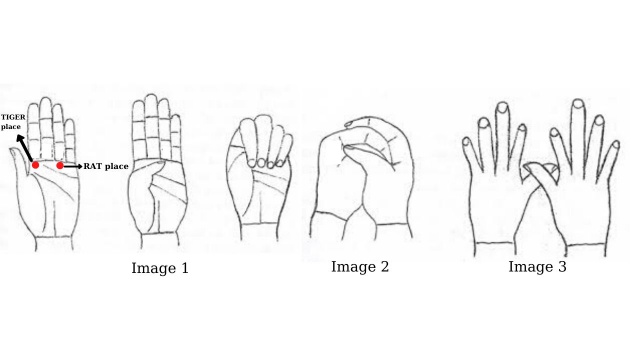
*Why must “Ấn Tý” to be placed at the middle of chest (the position of our Heart or “ Tâm” in Vietnamese)?
It is said that “Vạn Pháp do Tâm tạo” (all Dharmas are generated by our Heart), so we understand that the Heart (inner mind) plays a decisive role in everything. Thus, we must place the “Ấn Tý” at the position of the Heart. By acting on our Heart, we govern all powers in the Universe.
God’s messages:
-
“Nơi lòng Thầy ngự, động Thầy hay”[3]. Literally, the Supreme Being (God) dwells in our Heart and He Himself knows absolutely everything generating from our inner mind.
-
“By My Spirit alone [Chơn Thần], I created all the spirits of Buddhas, Immortals, Saints, Genies and Humanity all over the Cosmos, thus all of you are Me, and I am all of you [nên chi các con là Thầy, Thầy là các con]”[4].
*Further discussions about Ấn Tý:
Ấn Tý (also called the Mudra of the Jade Emperor - Lord of the Cosmos) is exclusively privileged to Caodaism.
We can also symbolize the Mudra as a flower bud in the First Era of Salvation, as a blooming flower in the Second, and as a fruit in the Third. And the fruit indicates universal unity which is a result of previous Salvation Eras.
The Juridical Conservator Nguyen Trung Hau (one of 12 Zodiacal Lords) lectured:
“The spread of Caodaism can be compared to an open flower becoming fruit, this fruit refers to the result and the clasped hands look like as we are holding the fruit. But the fruit must not be exclusive to anyone, instead it must be for all together, that we call Phổ Độ [Phổ: Universal, Độ: Salvation]. Therefore, when prostrating ourselves we spread out our hands as when we are planting seeds. Furthermore, this way of prostrating is pursuant to the way that Heaven and Earth were created. Right hand covers the left to form the harmony of Yin Yang (right: Yin, left: Yang). Yin forces embrace Yang forces to generate Supreme Monad which is symbolized by clasped hands. The Supreme Monad creates Two constitutive forces which is symbolized by two thumbs; and when we prostrate, our two thumbs must be juxtaposed to form the cross; this is the symbol of the Four Phenomena being generated by Two constitutive forces. The remaining eight fingers are spread out as what we call Eight Trigrams. By following this way, there will be many people who later release themselves from the secular world and become Divinities that we identify as a limitless transformation.”[5].
Question 2: In Caodai costume, why do men wear the turban but women do not?
Answer: The Caodai costume also originates from Vietnamese traditional costume. So men keep wearing the turban and women often have a hair bun or loosen their hair.
Question 3: The color in Caodai costume
*Why is the color of Caodai adept’s costume white?
Answer: White is the combination of all the colors, and it also represents “the Cosmic Fluid” (Hư vô chi khí), which is extremely pure.
Other colors are implicit for different races, appearances, and Dharmas in Heaven and Earth. All of them combine together to the only one Dharma, which is white in color.
That is the reason why Caodai choose the white color for the Caodai costume, implying the meaning of Caodai’s doctrine: Universal Equality.
*Why does the vestment of Male Dignitaries (of Cửu Trùng Đài) have 3 colors: yellow, blue, and red? Why is the vestment of Female Dignitaries (of Cửu Trùng Đài) white?
Answer: The vestment of Male Dignitaries (of Cửu Trùng Đài) has three colors (yellow, blue, red) representing the unity of three religions (Yellow - Buddhism, Blue - Taoism, Red - Confucianism). These three colors also represent the Yin element and the Male Dignitary represents the Yang element, meaning in Yang there is Yin. The harmonization of Yin - Yang and Heaven - Earth are the core of Caodai’s doctrine.
In terms of Dharma, white also represents the Yang element and the Female Dignitary represents the Yin element. So the image of a Female Dignitary wearing the white vestment implies the balance of Yin and Yang; there is Yang in Yin, creating harmony.
Regarding Caodai’s philosophy, the Holy Mother Goddess is the Supreme Ether who governs the Dharma and creates all living beings in Heaven and Earth. The Holy Mother Goddess chooses the white (Yang Element) to harmonize with God the Father. Caodai women follow the spirit of the Holy Mother Goddess who is the primary source of creation, wearing the white vestment, because white can transform to other colors.
The Juridical Reformer Tran Duy Nghia lectured: “The Pope’s vestment is white which is the origin color of Tao. Tao is colorless, represented by an extremely pure color: white, which can transform to other colors such as yellow, red… Retransforming to the white means returning to the origin.” [6]
Question 4: According to the teachings of the Cao Dai religion, where does the Spirit go after death?
Answer:
Per Caodai teachings, our material body dies but our spirit returns to the spirit-world, and is eternal. When your spirit returns to the spirit-world, you will meet all your friends and relatives of the life that you have just quit, as well as of all of your previous lives. You will be judged by the Tribunal of Conscience to determine your accomplishments and your sins and decide on your level of advancement or degree of purification. The consequences are either you would move up in the hierarchy of the spirit world, or you would stay put in your current degree, or you will require to return to Earth to pay your debts (i.e karma law, to be subject to reincarnation).
Question 5: In the Caodaism community, are Men and Women equal or not?
Answer:
Caodaism also teaches, in its ethical concepts, the equality and brotherhood of all races, and the love of justice; hence, Men and Women are equal in the Caodaist community. Female Dignitaries are in equal power with the Male Dignitaries. In practice, the Male greets (or bows down) first when they meet the Female Dignitary with a higher rank than himself.
However, Women cannot be promoted to the rank of Pope[7], this position must be reserved for men.
Question 6 : Why cannot a woman become Pope ? Why are women and men separated at ceremonies ?
Answer: The answer can be found in the Cao Dai Constitution (PHAP CHANH TRUYEN) . To clearly understand why, you must understand first the notion of YIN and YANG, and second the theory of the BIG BANG and the creation of the Universe.
“Heaven and Earth possess two constitutive Elements : The YIN and the YANG. If the YANG dominates, everything lives. If the YIN rules, everything dies. Thanks to the preponderance of the YANG, the whole Universe survives, and living beings develop. If a day comes when the YANG disappeared and the YIN reigned, on that day, the Universe would fall into decay and would be destroyed ! The Sun is the image of the YANG, and the Moon the image of the YIN. Men represent the YANG, and women the YIN. If I allow the College of Women to hold the power of the Pope in its hands, I will be sanctioning the triumph of the YIN over the YANG, so that the Holy Doctrine will be brought to nothing.” (Message by the Divine Master to the Ho Phap Pham Cong Tac).
GOD is considered as a Male element from the above theories. The GIAO TONG or POPE represents GOD in some circumstances, thus Cao Dai does not want a female in charge of the religion because it would change everything from the Yin and Yang notion. The GODDESS MOTHER (called DUC PHAT MAU) represents the Female element, and according to our teachings, the Goddess Mother receives instructions from God or Duc Cao Dai, but is not equal to Him.
With this same YIN and YANG theory, men and women stand separated at ceremonies to show that each gender has also its own organization and authority. Nevertheless, they are equal in ranks and hierarchy. “The dignitaries, whether masculine or feminine, who are on the same levels have the same powers. The Priests of the College of Men must be placed under the orders of the Bishops of The College of Women, just as the Bishops of the College of Women must obey the Archbishops of the College of Men. Equality is for all, but powers differ according to the dignitaries of the Sacerdotal Council.”
Question 7: When parents are Caodaists, must their children follow the Cao Dai religion?
Answer:
Caodaism does not require the Caodaist children to follow their parents’ religion. It is their choice to follow or not when they become adults (18 years of age).
Question 8: Has Caodai established school to provide education in Caodai doctrine? What about Caodai studies for children?
Answer:
In terms of education for children, Caodai laws and regulations regard it as compulsory for children 6 years or older. Private school is optional. In the past, Caodai established school systems (including Elementary, Secondary and University) providing general and religious education for Cao Dai students. But since 1975, the school system was abolished by the government, because the government’s policy is that only the government can be in charge of educating the children.
In terms of education for Cao Dai followers, there is no parochial Caodai-established school system. Instead, we have a Caodai institution in every village congregation called Bàn Trị Sự[8] (local Congregations) who plays the role of a Minor Sacerdotal Council (in Vietnamese “Hội Thánh Em”- Hội Thánh: Sacerdotal Council, Em: younger brothers) with the responsibility to educate followers placed under their authority in the local jurisdiction..
The Religious Constitution, Chapter 10 provisioned the powers of Phó Trị Sự (Deputy Religious Village Chief): “They are entrusted with guiding, teaching and helping the Adepts placed under their authority”.
In term of religious education for Dignitaries, Caodai has annually run a short-term course called “Hạnh Đường” (training school for Dignitaries) to teach Caodai doctrine and practices for Dignitaries.
Question 9: What does Nine Levels in the Cuu Trung Dai (Nine Sphere Palace) represent?
Answer: In the Nine Sphere Palace, the Nine stages represent the Nine grades of the Heaven, which are the nine degrees of evolution of Human Beings in the Spiritual World (the Nine Divine levels in Nirvana) and also the nine ranks in the Cao Dai religion in the virtual world.
These degrees include:
|
|
Temporal ranks
|
Divine ranks – Célestial Hierarchy (English name taken from Dionysius the Areopagite)
|
|
1
|
Giáo Tông (Pope)
|
Thiên Tiên (Seraphim)
|
|
2
|
Chưởng Pháp (Censor Cardinal)
|
Nhơn Tiên (Cherubim)
|
|
3
|
Đầu Sư (Cardinal)
|
Địa Tiên (Throne)
|
|
4
|
Phối Sư (Archbishop)
|
Thiên Thánh (Dominion)
|
|
5
|
Giáo Sư (Bishop)
|
Nhơn Thánh (Virtue)
|
|
6
|
Giáo Hữu (Priest)
|
Địa Thánh (Power)
|
|
7
|
Lễ Sanh (Student Priest or Deacon)
|
Thiên Thần (Principality)
|
|
8
|
Chức Việc (Sub Dignitary)
|
Nhơn Thần (Archangel)
|
|
9
|
Đạo Hữu (Disciple)
|
Địa Thần (Guardian Angel)
|
The Juridical Legislator Trương Văn Tràng lectured: “The architecture of the Nine Sphere Palace was designed according to the Nine grades of Heaven. This Palace has Nine stages with different elevations/ranks. The Nine Grade Divinities [Cửu Phẩm Thần Tiên] receive instructions from “Ngọc Hư Cung” (White Jade Palace, the place where God reigns and manages the Universe) in the Spiritual World, which is reflected exactly the same in the Virtual World where Nine Ranks of Cao Dai Dignitaries obey the “Bát Quái Đài's” orders (Eight Trigrams Palace). This part is in charge of the administration of the Religion and Missionary activities”[9]
*Why do the Dignitaries with different ranks stand at different levels in the Great Temple ?
According to the philosophy of Caodaism, the rank of Cao Dai Dignitaries corresponds with that rank in the Spiritual World. And the nine levels at this temple represent that order in the Spiritual World. Therefore, dignitaries must stand at a position corresponding to their rank.
Question 10: What do the Dragon Pillars in the Temple stand for?
Answer: Inside the Cao Dai Holy See, there are 28 Dragon Pillars, symbolizing the 28 constellations. In ancient Chinese astronomy, there are 28 constellations, spreading in the four directions of East, West, South, and North. According to the traditional concept and philosophy of Caodaism, the constellations (or the stars) are also symbolic images for the Genies, Saints, Immortals and Buddhas worshiping God in the White Jade Palace (Bạch Ngọc Kinh).
The Eighth Muse in Dieu Tri Palace (Bát Nương Diêu Trì Cung) lectured: “Every night you face up to the sky, you see thousands of stars; those are the three thousand worlds mentioned earlier. Stars that are scientifically known as stellar are the places where the Great Seraphims govern their worlds. And the stars that are called planets are the places where the spirits are performing their missions”[10].
The word "dragon" is associated with good fortune and is thought to have power over rain. To Cao Dai, the dragon is the symbol of the spirit of Heaven and Earth. In the ancient Religions, there were usually statues of Buddhas, Immortals, Saints and Genies. However, Caodaism with its principle of universal unity and unification of religions, chose the image of the dragon to worship God, rather than the image of a Buddha or any Saint, i.e dragons replace the Divinities.
Question 11: What is the meaning of the Bell and the Drum in the commencement of the “High Mass” (Đại Đàn) at the Cao Dai Great Temple?
Answer: The “High Mass” (Đại Đàn), at the “Lôi Âm Cổ Đài” (Drum Tower) commences with the drummer shouting Ngọc Hoàng Sấm (In Vietnamese, Ngọc Hoàng: Jade Emperor, Sấm: Thunder), which is then followed by the bell at “Bạch Ngọc Chung Đài” (Bell Tower).
The drum sound (emitting a roar “Om” or “Aum”) represents the first explosion of the Big Bang generating numerous stars, from which the Universe was created. After the explosion, there were loud roars that are symbolized by the bell sound. The drum sound is the root, representing the Yang Element, often used in the East. The Bell is the tip and the sound that follows, representing the Yin Element, commonly used in the West. The Bell and the Drum recalled the origin of the Universe and also the harmony of Yin and Yang.
His Holiness Hộ Pháp Phạm Công Tắc lectured: “In the East culture, there are bell and drum, but in the West culture there is only a bell without a drum. Why does the East use the drum but the West use the bell? Drums are the sounds of the Tao. When there was no Universe, the Taoist lectured that: The two lines of gas burst and exploded, and the fire was “Thái Cực” or Supreme Monad. The master of Thái Cực/Supreme Monad’s throne is the Supreme Being or God. When there is lightning, what can we hear? In the South, it sounds like ùm’ (Om or Aum) and in the Dharma it sounds like 'úm', because of the Buddha's correction, it is translated into 'úm' (úm ma ni bát rị hồng - Om Mani Padme Hum), meaning to attain the universal power at hand.
How do we hear it? When it explodes, it transmits away, the cause of the explosion is the drum, and its reverberation is the bell sound”[11].
Question 12: What is the meaning of “Hoán Đàn” procession, i.e dignitaries and followers start walking from the first seat level to the 9th seat level and returning to the first seat level, then standing at their designated ranks.
Answer: In terms of the Dharma, “Hoan Dan” ritual (the rite of circulation) is the operation of the Falun or Wheel of Dharma (Pháp Luân Thường Chuyển), which symbolizes the influx of all living beings (the classes of spirits) circulating in the Cosmic Universe.
According to Cao Dai philosophy, all beings must evolve from Material to Plant, Animal, and to Human. After that, Human Beings must continue to evolve through the Nine Divine Stages, representing the stepping up through the Nine Degrees of Cửu Trùng Đài (Nine Sphere Palace). After climbing up the ladder of the Nine Divine Stages, they do not remain at that stage but have to descend/ reincarnate, starting from the Material to re-evolve. That is why the Buddha descended to save and bring human beings back to God, so that he could attain his Divine Position in Nirvana.
His Holiness Hộ Pháp Phạm Công Tắc lectured about the meaning of Hoan Dan: “Step up to each Heaven to let the soul elevate to the class of Saints and to Buddha. That said, the Buddha descends to the Human world, then the Human world returns to Buddha, turning like that, the esoteric Dharma called Enlightenment”[12].
The "Hoan Dan" ritual (The rite of circulation) in a Great Ceremony (2020)
Question 13: What is the meaning of the ritual “Offering of Three Treasures” and why do Flower, Wine and Tea symbolize the Three Treasures?
Answer:
*The meaning of the ritual: The Offering of Three Treasures [Vietnamese: Dâng Tam Bửu] is a Caodaist ritual by which Caodaists offer their own Tinh (Matter), Khí (Vital essence/ qi), Thần (Soul) to God. In Caodai teachings, humans are constituted by three essential elements: Matter, Vital Essence and Soul which are initially given by God and the Holy Mother Goddess. So through this ritual, all three of them will be reunited to Heaven and Earth (and then belong to God). It is said that “Phản bổn hoàn nguyên” (meaning: they return to the original state).
*The reason why Flower, Wine and Tea are chosen to be symbolic objects: In Caodai teachings, Three Treasures refer to the three most precious ritual elements and we have:
-
Three treasures of Heaven: Nhựt (Sun) – Nguyệt (Moon) – Tinh (Stars)
-
Three treasures of Earth: Thủy (Water) – Hỏa (Fire) – Phong (Ether)
-
Three treasures of Human: Tinh (Matter) – Khí (Vital Essence) – Thần (Soul)
And three treasures of human are symbolized by Flower (for Matter), Wine (for Vital Essence) and Tea (for Soul).
-
Flower: with its diversity of appearances and colors, the flower indicates freshness and beauty. And the TINH (Matter, or physical body) can be compared to the “flower” which has been nourished by the matter of Heaven and Earth.
-
Wine: because of its purity (from the production process) and strong vapor, wine was chosen to symbolize the KHÍ (Vital Essence/ qi) which constitutes human energy and mind.
-
Tea: tea brings reconciliation and harmony. And the THẦN (soul, spirit of human) is the owner of our wisdom and consciousness.
His Holiness Hộ Pháp Phạm Công Tắc instructed: “I want to remind you of the ritual of Offering of Three Treasures. At the time of the flower offering which means we offer our physical body, we bow down and pray to the Supreme: “I offer to You, the Supreme, my body which would be used by Your own free-will”. At the time of the wine offering, we pray: “I offer to You, the Supreme, my mind which would be used by Your own free-will”. At the time of the tea offering, we pray: “I offer to You, the Supreme, my soul which would be used by Your own free-will”. If we are wise, we know that the last prayer should be as follows: “My soul, my mind and my body have been trained by You, our Divine Master. Now they are Yours and absolutely under Your own authority”. That is the way we must pray to the Supreme. As I have instructed before, the reason why the Supreme chose a flower as a symbol of the physical body is that He wants to look on you, His children, as a flower’s beauty. By choosing the wine, He wants the mind of mankind to be as strong as wine. By choosing the tea, He wants the Spirit [soul] to be emerged [to the Universe] as tea [Ngài lấy là muốn chơn linh ra điều hòa như trà vậy]. These are essential reasons for His choice of these symbolic objects”[13].
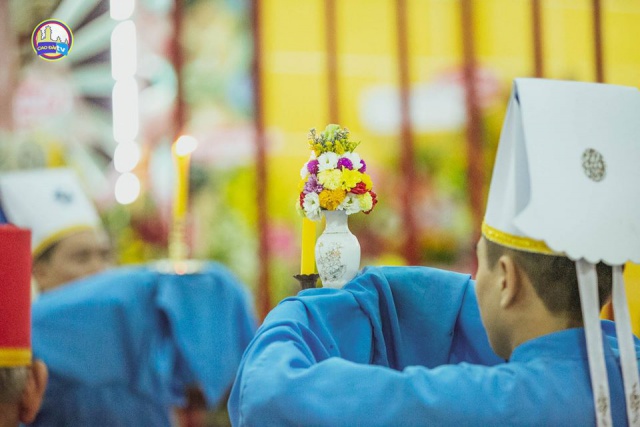
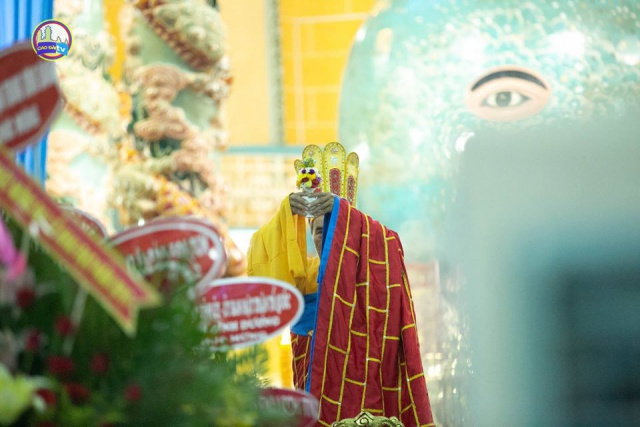
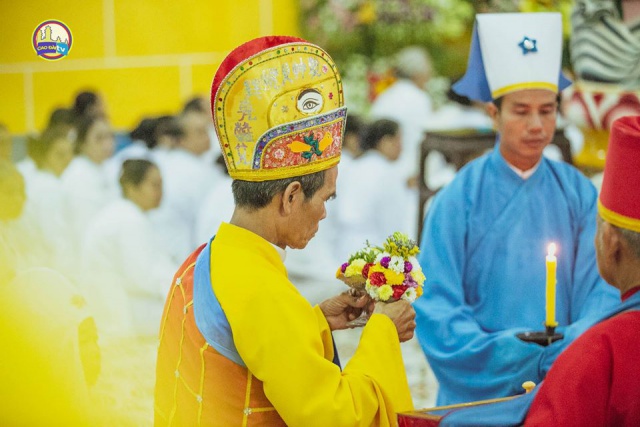
The Flower Offering (a part of The Ritual of Offering of Three treasures)
|
Question 14: What are the meanings of the standing of the children’s chorus and the orchestra at the Great Temple at the time of the High Mass?
Answer: The stand of the children’s chorus and the orchestra at the Holy Great Temple at the time of the High Mass is as follows:
*More information about “Nhac Tau Quan Thien” – the music to welcome the Divine Beings before the start of the High Mass (translated in common parlance “Hail to the Chief”)
On the Commemoration Ceremony of God and the fìftieth days of the first, seventh, tenth of the lunar month (Three Circles – Tam Ngươn)[16], “Nhac Tau Quan Thien” includes seven pieces of music that represent seven stages of the creation of the Universe and the generation of all things - seven stages of evolution of all the living beings, including:
-
Xàng Xê: the Chaotic period, during which there did not exist Yin and Yang.
-
Ngũ Đối Thượng: the period of separation of Yin and Yang.
-
Ngũ Đối Hạ: the period of putting all things in order, creating hierarchy.
-
Long Đăng: Yang energy is the light pure element that transformed into heaven.
-
Long Ngâm: Yin energy is the heavy element that transformed into earth.
-
Vạn Giá: the period of creating and naming living beings.
-
Tiểu Khúc: the period of living beings that have differences in the body and physiognomy.
Musical Ritual Band performing religious "Hail to the Chief"
Question 15: What is the meaning of the lamps of Three Religions ?
Answer: In the Caodai ritual, the lamps of Three Religions are used in the ritual of Chỉnh sát Cúng phẩm – examing and arranging the offerings - which is the ritual of offering Three Treasures to God the Father. In that case, three couples of ceremonial persons who represent three religious branches hold three couples of the lamps of Three Religions (two in yellow, two in blue, two in red) slowly going to the exterior table, and the Dignitary escorting the precious trunks with Three Treasures (Flower – Wine – Tea) follows.
The lamps of Three Religions represent each follower’s
fire energy, or soul of fire. This fire will bring the Three Treasures (
Matter –
The Vital Essence –
The Soul) of each person back to the origin; it means that they unite as One with God the Father.
The lamps of Three Religions are leading the Three Treasures
(The High Mass on the fiftieth day of October Ky Hoi 2019 Ceremony of Ha Nguon – Photos by Caodai TV)
|
A dignitary is escorting the precious trunk with the Three Treasures
Photos by: Caodai TV
|
Question 16: Why do Ritual persons / Acolytes (Lễ Sĩ) hold the candle (Light) while performing? What does that mean?
Answer: The Candle (called Light) is used for the ritual of Offering the Three Treasures in times of Great Ceremonies. Accordingly, in each time of offering Flower, Wine, and Tea to God the Father, there will be two couples of ceremonial persons that include:
Per Caodai teachings, candle is the light (representing the Yang element). That the pair of candles are held by the Acolytes going first means that the Yang element is the master of leading the pair of wood base holders which are tangible matter (representing the Yin element) offered to God the Father.
In terms of Dharma, Three Treasures also symbolize Matter (material body which belongs to Post-creation). Matter cannot offer itself to God. Hence, the Light is used, representing The Soul (light, which belongs to Pre-creation, represents the wisdom or illumination of each follower). Offering Three Treasures along with a pair of Candles represents offering the unity of Matter and Soul to God the Father. Similarly, in the realm of the ignorant and secular world, each follower must use his Wisdom Light as the illumination torch which guides him to unite as One with God the Father.
Ritual persons/ Acolytes [Lễ Sĩ] hold the candles and wood base holders in the ritual of offering Three Treasures
(The High Mass on the fiftieth day of October Ky Hoi 2019 Ceremony of Ha Nguon – Photo by Caodai TV)
|
Thus, the Candles and the Wood base holders in the Caodai ritual symbolize the principle of harmony of Yin - Yang and unity of Matter - Soul.
Question 17: What is the meaning of the Salvation Boat (The hearse in the Caodai funeral Rite)?
Answer :
In the Caodaist Funeral Rite, the Salvation Boat (or Prajna Paramitta Boat) is used for the burial procession to God’s Cemetery.
In Cao Dai Philosophy, the Salvation Boat originated from the Creation of the Universe when Samantabhadra (Hoàng Cực Chủ Nhơn) executing (is there a better verb than executing? I don’t understand it) the Divine Mother as the Salvation’s leader, guided 100 million Original Spirits to this material World to establish the Way. The Original Spirits, tempted by the material world, distracted the origin (were distracted by the origin?) and suffered within the Ocean of human pain. For this, many religions have been founded to lead the Original Spirits back.
During the First and the Second Eras of Universal Salvation, religions enlightened eight million Original Spirits, but the other ninety-two million are still damned on Earth. And in this Third Amnesty of God, God reformed the Great Way- Caodaism- in the form of the Tao as the Salvation Boat in order that ninety-two Original Spirits were enlightened to reach the primordial position. Therefore, the Hearse Prajna Paramitta Boat symbolizes the sacred origin and also implies the Universal Salvation of Caodaism.
* Further discussion of the Hearse Prajna Paramitta Boat:
In the tangible World, the Salvation Boat is a Dragon Boat, carrying the believers’ corpse-physical body to the cemetery. In terms of Dharma, the Hearse Prajna Paramitta Boat is a Taoism Boat that takes man, passing the Confusion River, back to Nirvana. The word “Prajna” means “Wisdom or Great Understanding” while Buddha calls it “Enlightenment”, implying Original Spirits only used wisdom, relying on the Hearse Prajna Paramitta Boat, to reclaim their primordial position.
Extract from the Compilation of Divine Messages: “Therefore, Supreme God and Buddhas, Immortals, and Saints founded the Third Universal Salvation to save all living beings who are still suffering. If they miss this chance to embark and do not follow the Prajna Paramitta Boat, they will remain in the Solitary Confusion River”[17].
Question 18: What is the Enlightenment Palace (Trí Huệ Cung) and why was the Enlightenment Palace painted yellow?
Answer: The Enlightenment Palace, a meditation House, is an esoteric training school for meditation in the Caodaist practices, rules and regulations. In 1951, His Holiness Hộ Pháp meditated at the Enlightenment Palace for three months. The Enlightenment Palace was painted yellow as it is the “Cửa Phật” (Cửa: entrance, Phật: Buddha) and yellow symbolizes Buddhism.
Question 19: After Hộ Pháp died (ascended to Heaven), did Caodai adherents have any ways to get Divine messages from Hộ Pháp?
Answer: After Hộ Pháp died (ascended to Heaven), His Holiness manifested in séances regularly with the Cao Dai Sacerdotal Council and always reminded people to strictly follow Cao Dai teachings such as the Religious Constitution and the Canonical Codes, as well as to instruct humanity in the path of virtue. His Holiness also guided the Sacerdotal Council in the management of the religion and helped to solve hardships and difficulties.
Question 20: At the Festival parade performance, what are the meanings of the four sacred animals (dragon, unicorn, tortoise and phoenix) and how are they related to Cao Dai?
Answer: The four sacred animals (dragon, unicorn, tortoise, phoenix) always perform at parades in Great Festivals, symbolizing worship of the Holy Spirits and celebration of festivals. According to the traditional ancient culture and Cao Đài teachings, these four Supernatural Animals would bring prosperity and aura to humanity when appearing on Earth.
______________________________
Compiled by Thanh Thuy and the Cao Dai Interpreter Youth Group
Corrected by Rev. Canh Tran and Chancellor’s Professor Joe Hobbs
California, May 2020
[1] Compilation of Divine Messages, Vietnamese version, Book 1, 1973, page 11
[2] Compilation of Divine Messages, Vietnamese version, Book 2, 1970, page 62
[3] Compilation of Divine Messages, Vietnamese version, Book 1, 1973, page 123
[4] Compilation of Divine Messages, Vietnamese version, Book 1, 1973, page 31
[5] Luận Đạo vấn đáp (The Doctrines in Questions and Answers), The Juridical Conservator Nguyen Trung Hau, 1972, page 24
[6] Chánh Trị Đạo (Politics of the Religion), The Juridical Reformer Tran Duy Nghia, Vietnamese version, 1974, page 44
[7] The reason for this issue: it was explained in the Religious Constitution, in Female Dignitaries Section
[8] Bàn Trị Sự is an Administrative Committee of a religious village, including Chánh trị sự (Religious Village Chief), Phó trị sự (Deputy Religious Village Chief) and Thông Sự (Religious Village Administrators)
[9] Giáo lý (Caodai Doctrine), The Juridical Legislator Trương Văn Tràng, Vietnamese version, 1974, page 43
[10] The sacred message of The Eighth Muse Dieu Tri Palace (in a séance 16th first month of Lunar year of Dragon -1988)
[11] Hộ Pháp Phạm Công Tắc, Lời Thuyết Đạo của Đức Hộ Pháp (Sermons of Ho Phap), Book 2, Lesson 28 (23/05/1948)
[12] Hộ Pháp Phạm Công Tắc, Lời Thuyết Đạo của Đức Hộ Pháp (Sermons of Ho Phap), Book 2 (sermon in 25-03-1948)
[13] Hộ Pháp Phạm Công Tắc, Lời Thuyết Đạo của Đức Hộ Pháp (Sermons of Ho Phap), Book 1 (sermon in 1st day of Twelfth month of Lunar year of Pig- 1948)
[14] Nam Xuan is a melody in Vietnamese traditional music.
[15] Nam Ai is also a melody in Vietnamese traditional music.
[16] Great Ceremonies in Three Circles (Tam Ngươn) in a lunar year: Ceremony of Thuong Nguon (beginning of year), Ceremony of Trung Nguon (middle part of the year), Ceremony of Ha Nguon (the last period of year)
[17] Compilation of Divine Messages, Vietnamese version, Book 1, 1973, page 87

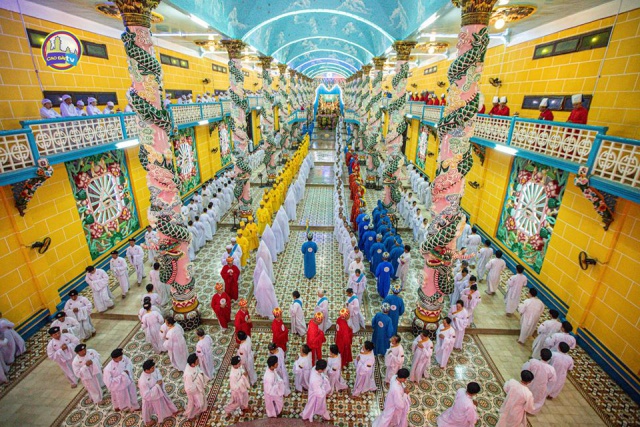



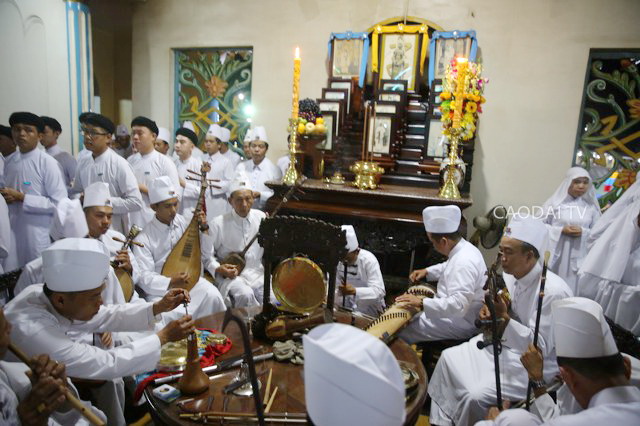
.jpg)
.jpg)
